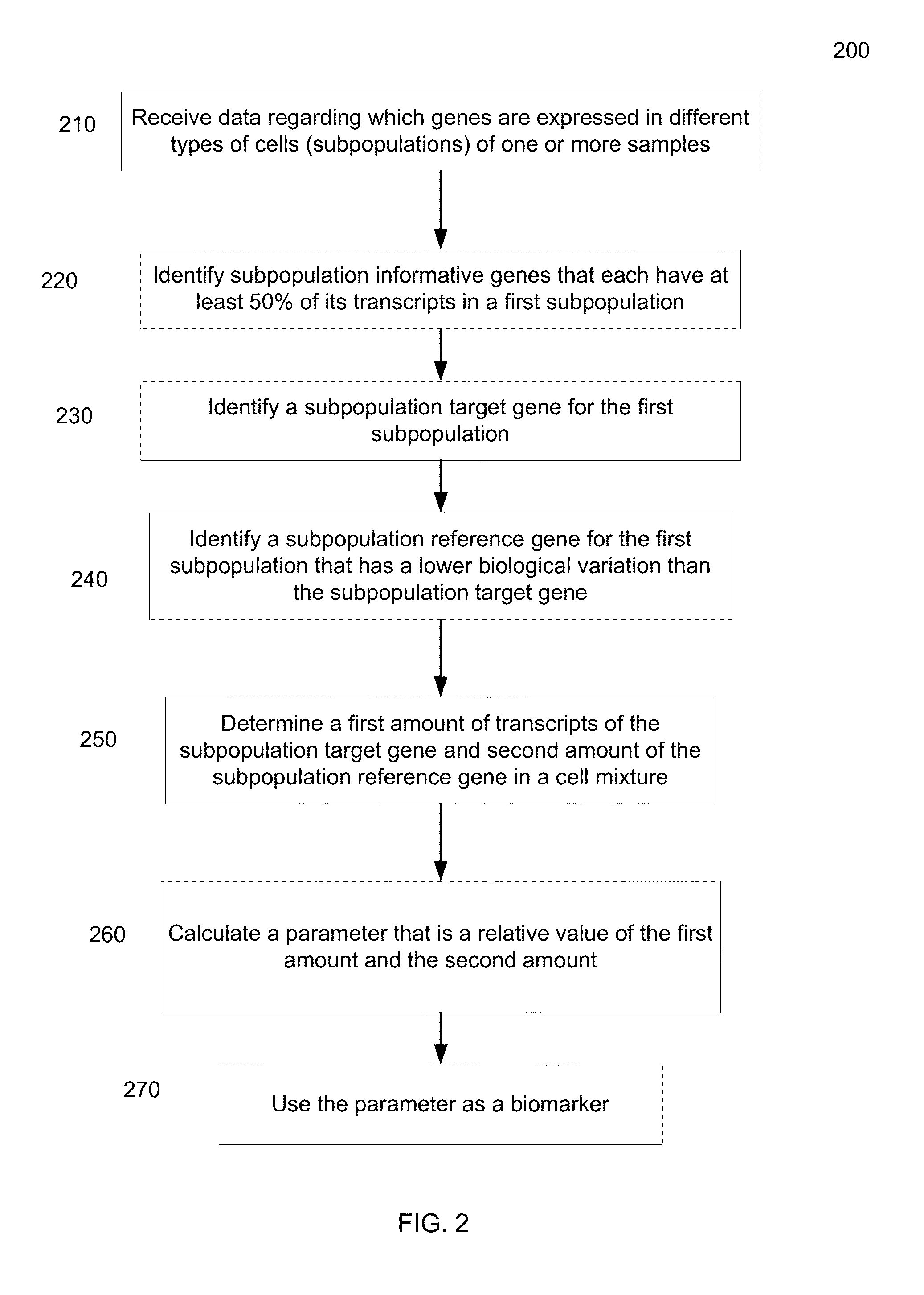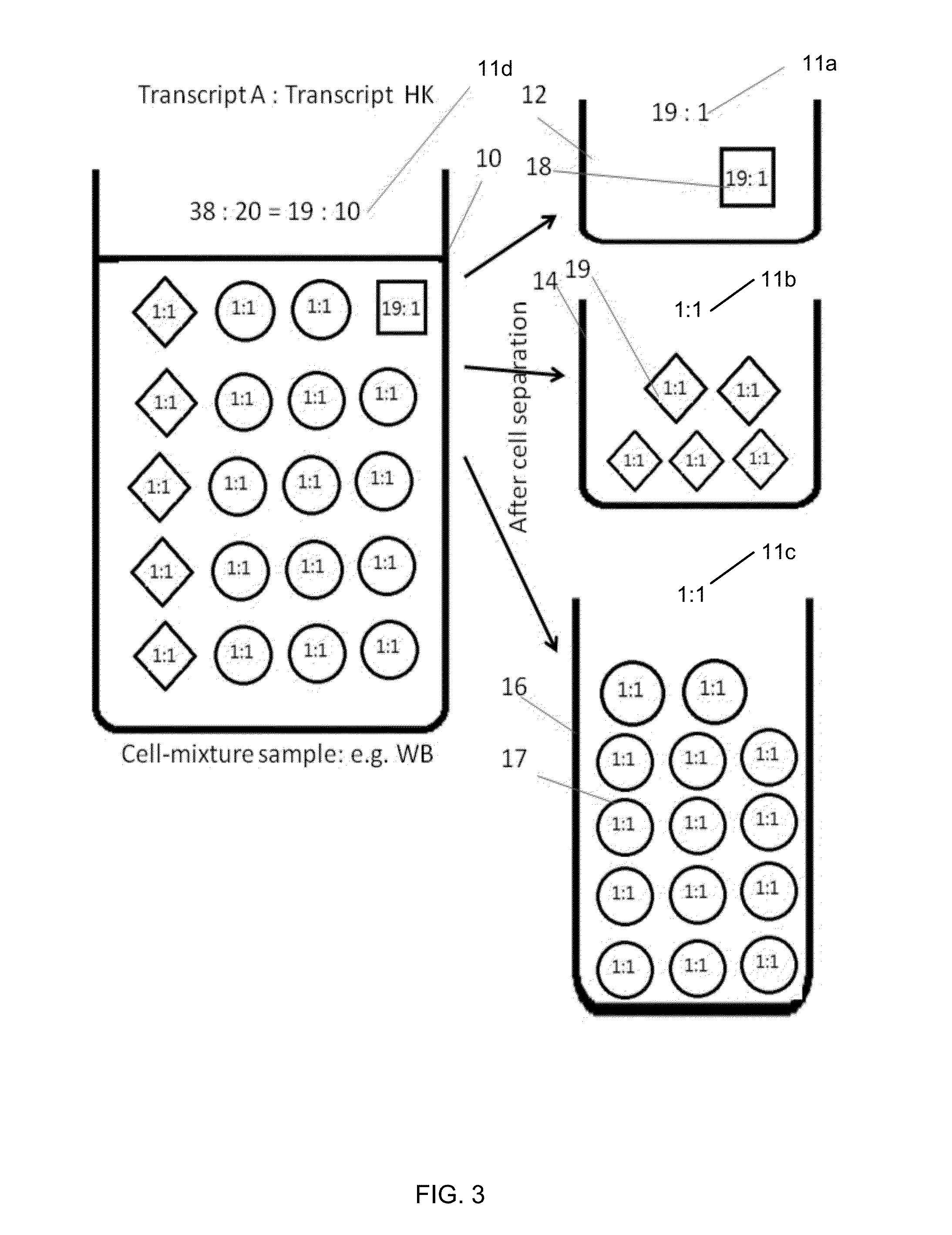Determination of gene expression levels of a cell type
a cell type and gene expression technology, applied in the field of gene expression level analysis, can solve the problems of inpractical procedures in the setting of clinical service laboratories, laborious and tedious cell subpopulation separation, and limitations in current methods of gene expression analysis in peripheral blood samples
- Summary
- Abstract
- Description
- Claims
- Application Information
AI Technical Summary
Benefits of technology
Problems solved by technology
Method used
Image
Examples
example 1
V-1. Example 1
B Lymphocytes
[0130]The following examples are provided by way of illustration only and not by way of limitation. Those of skill in the art will readily recognize a variety of non-critical parameters that could be changed or modified to yield essentially the same or similar results.
[0131]A. Preparation
[0132]Blood samples were collected from 22 healthy volunteers. All samples were processed to collect B lymophocytes by magnetic bead cell separation. Quantification of candidate references genes were carried out in (1) Peripheral whole blood treated with Tizol, (2) peripheral blood collected in PAX tubes, (3) PBMC collected by Ficoll preparation and (4) the purified B lymphocytes by 2 steps reverse transcription real-time PCR.
[0133]Although both red blood cells and platelets are not nucleated cell, both contains gene transcripts. However, both of them only contain transcripts of much smaller number of genes than nucleated hematopoietic subpopulations, which is the leukocyt...
example 2
V-2. Example 2
Total T Lymphocytes
[0152]Regarding methods and subjects, blood samples of thirty consented healthy individuals were included in this example. Two types of samples were used, which were (1) peripheral whole blood immediately treated with Trizol reagent (Invitrogen, US) after collection and (2) CD3 total T cells separated (or enriched) samples from each individuals. For isolation of CD3+ve total T cells subpopulation, PBMC was prepared from freshly collected whole blood samples. Then CD3 micro beads (Miltenyi Biotec) was added. After incubation as instructed by the manufacturer's protocol, the mixture was then washed and passed through a magnetic field in a LS column (Miltenyi Biotec). After further rounds of washing inside the column, the enriched / purified samples of the CD3+ve T cells subpopulation were harvested by elution after removal of the magnetic field. An aliquot of the enriched sample was analysed by two-color immunofluorescence flow cytometry to confirm enric...
example 3
V-3. Example 3
Granulocytes
[0159]Regarding methods and subjects, blood samples of eighty consented healthy individuals were included in this example. In this example, two types of samples were used, which were (1) peripheral whole blood immediately treated with Trizol reagent (Invitrogen, US) after collection and (2) granulocytes separated (or enriched) samples from each individuals. Granulocyte subpopulation was separated from other nucleated cells by Ficoll solution following standard protocol. Granulocytes were collected from the Ficoll-RBC interface after standing in room temperature and centrifugation. After rounds of washing, the enriched / purified samples of granulocytes subpopulation were collected as pellet after centrifugation and treated by Trizol reagent and stored at −80° C.
[0160]TA of the following candidate genes were examined by real-time QPCR after reverse transcription: AQP1, BCL2A1, CEACAM6, CEACAM8, Clorf24, CSF2, DEFA4, FCGR3B, IL-4, IL-8, IL8RB, LTF, MMP25, MS4A3...
PUM
| Property | Measurement | Unit |
|---|---|---|
| volume | aaaaa | aaaaa |
| temperature | aaaaa | aaaaa |
| total volume | aaaaa | aaaaa |
Abstract
Description
Claims
Application Information
 Login to View More
Login to View More - R&D
- Intellectual Property
- Life Sciences
- Materials
- Tech Scout
- Unparalleled Data Quality
- Higher Quality Content
- 60% Fewer Hallucinations
Browse by: Latest US Patents, China's latest patents, Technical Efficacy Thesaurus, Application Domain, Technology Topic, Popular Technical Reports.
© 2025 PatSnap. All rights reserved.Legal|Privacy policy|Modern Slavery Act Transparency Statement|Sitemap|About US| Contact US: help@patsnap.com



